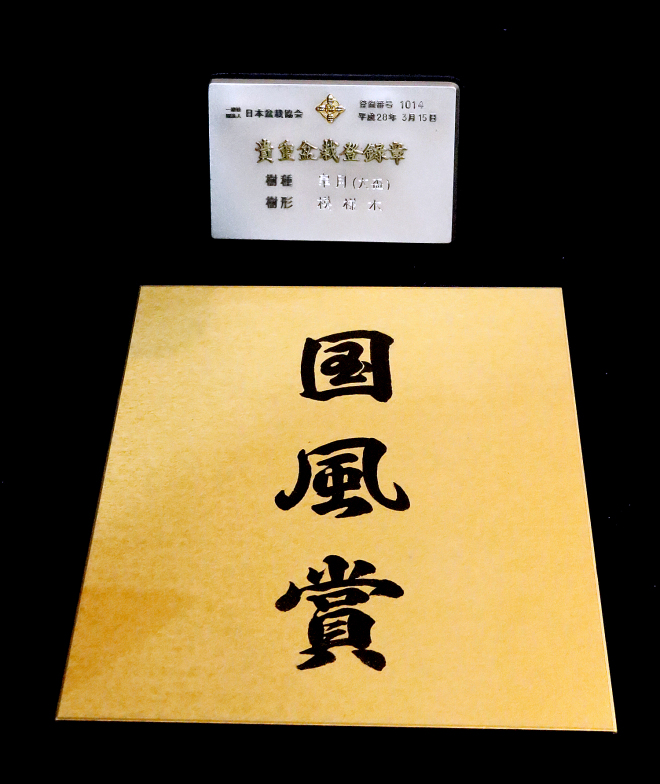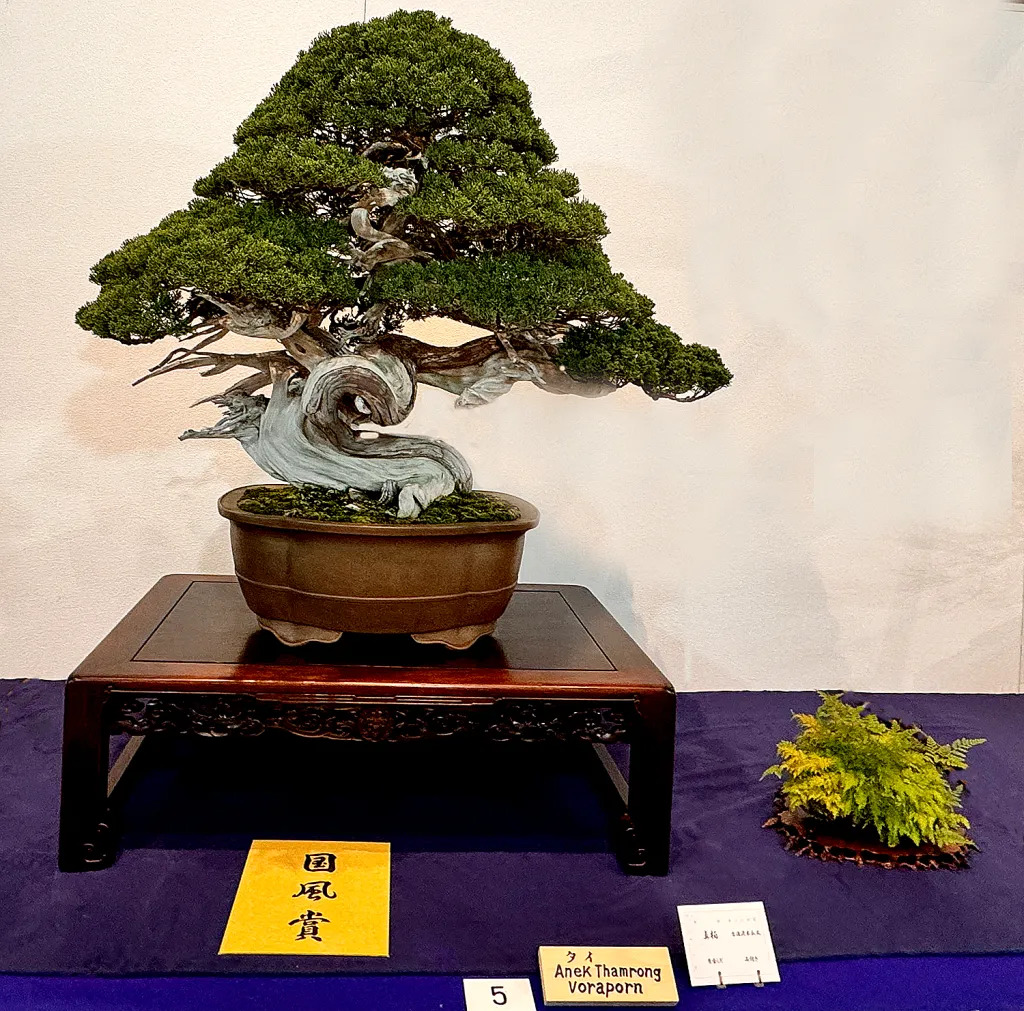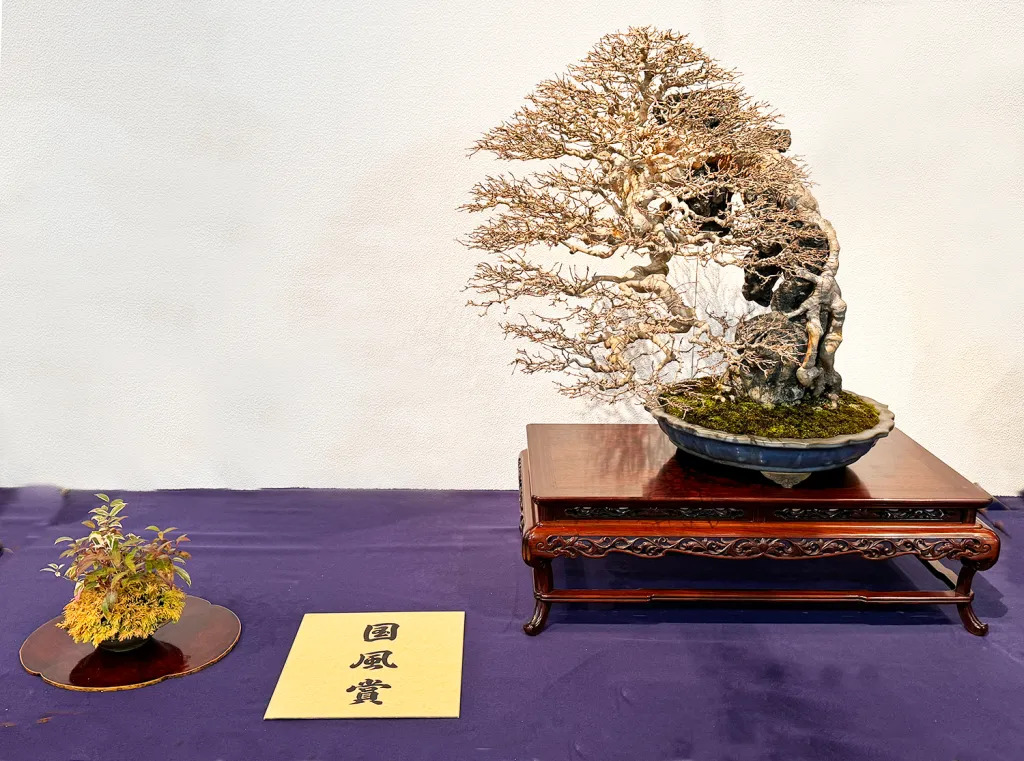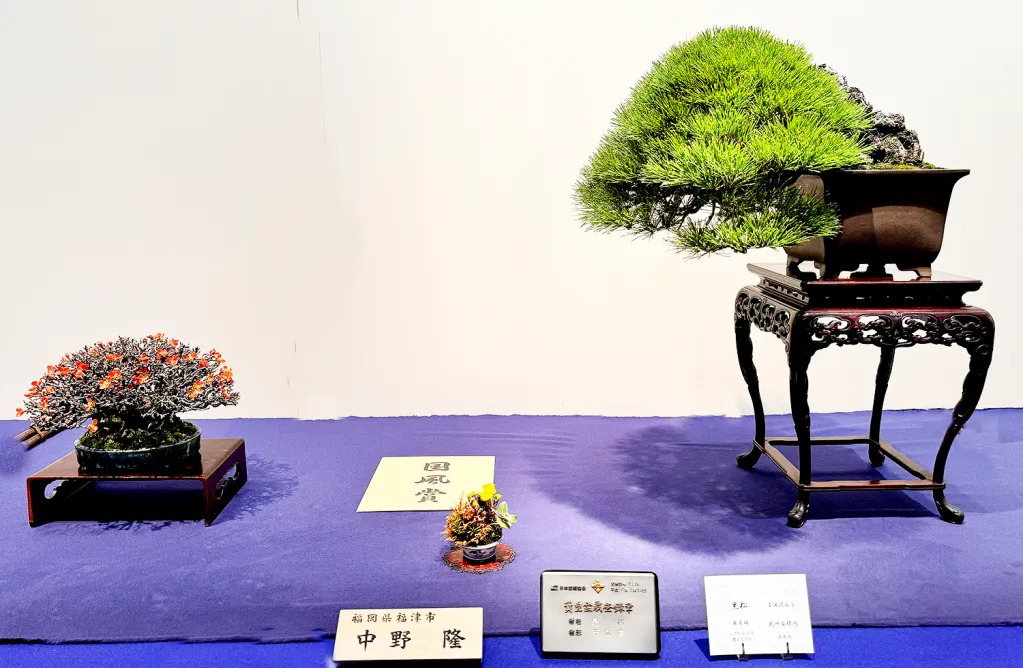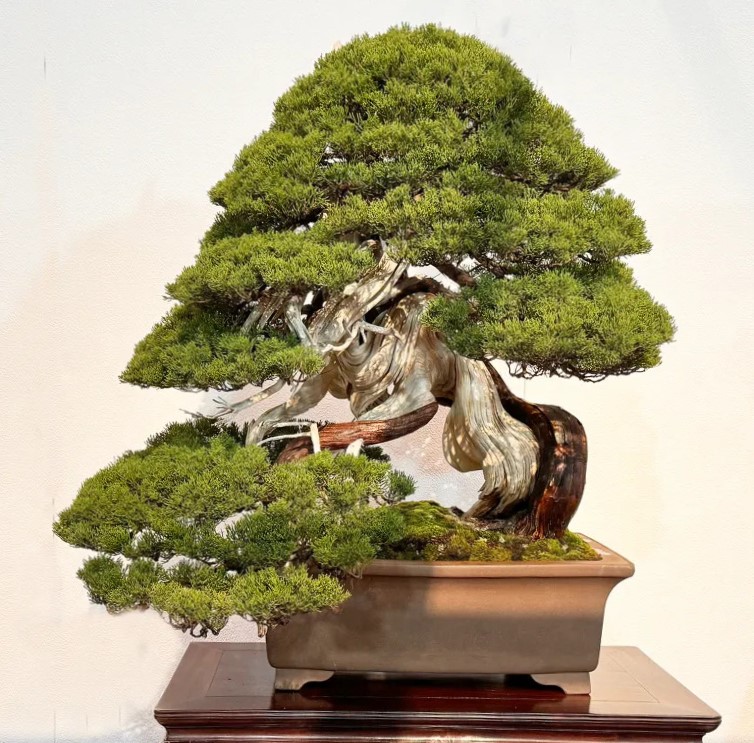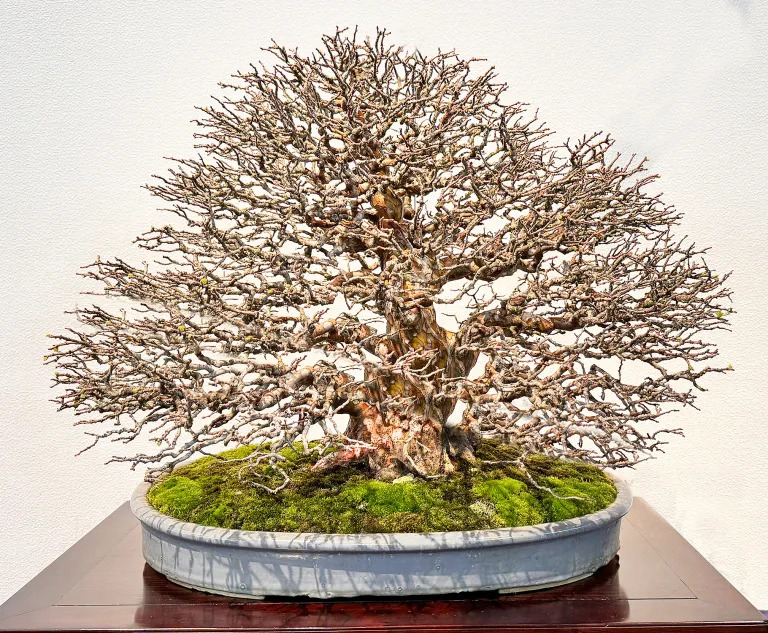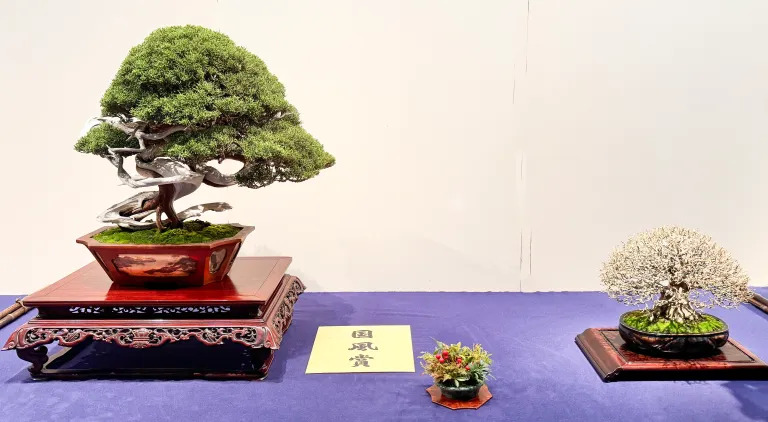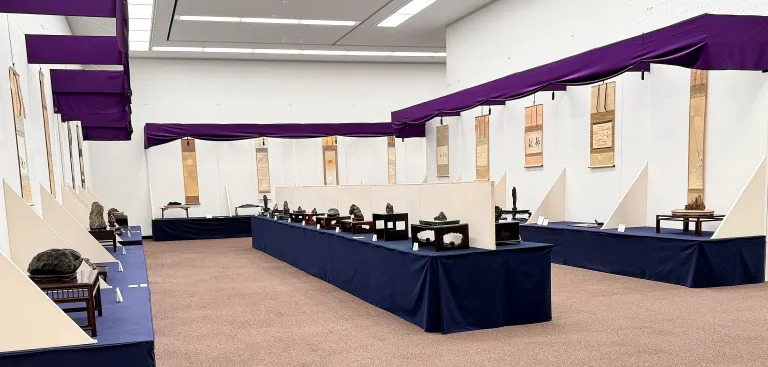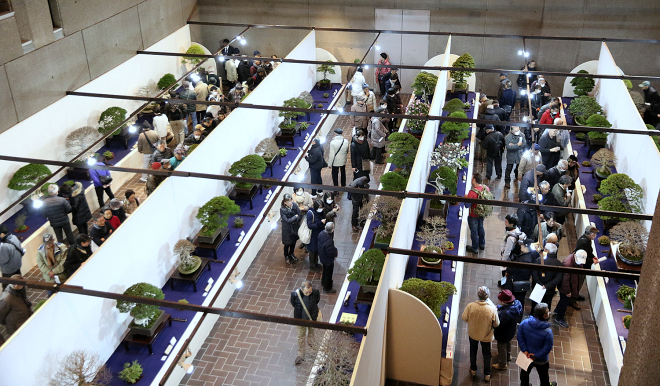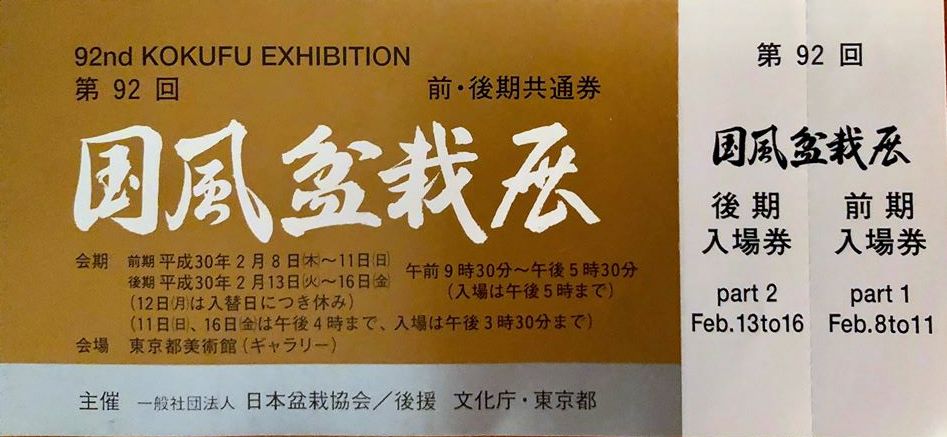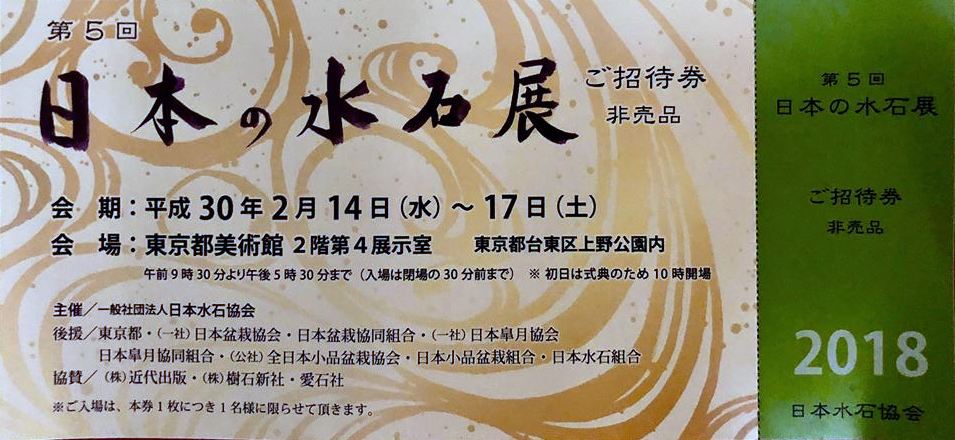On the northwest shore of
Lake Shinobazu in Ueno Park is the Bai ten.
This is the bonsai sales area set up to accommodate bonsai shoppers visiting the Kokufu Ten. Bai ten is a
mostly uncovered lot that is centered around a three-story building called the "Green Club." This
Ueno Green Club
is where bonsai vendors, nursery owners, and potters from all over Japan of every stripe set up stalls selling
their wares. Perhaps four dozen vendors are inside the building there and another five dozen are
outside. As vendors pay a little more for exhibit space inside the Green Club, it is typically filled
with higher-quality wares. Bai ten is one of the highlights of a bonsai tour to Japan. Not only are
there hundreds of great trees, pots, tools and other bonsai paraphernalia on site, but they are all for
sale. A 10-minute free shuttle bus trip from the museum runs continuously throughout the day to the
"club" area. Sometimes an
auction is also held. (The Tokyo Green Club in Ueno often has shows here on weekends throughout the
year, with trees, pots, tools, books, and magazines for sale.)
As former assistant curator of the U.S. National Bonsai & Penjing
Museum Aarin Packard observed in a mid-May 2014 entry in his blog:
"For the top bonsai professionals in Japan the Green Club during Kokufu
is very important to their livelihood. Selling trees and attracting clients is how these men feed
their families. First and foremost it's about sales. The Kokufu-ten draws people from all over the
world, many of whom are coming to shop for bonsai at the Green Club. This influences which trees are
brought to sale.
"You can think of each professional as a fisherman using his best lure
to catch the biggest fish. Currently the biggest fish come from China, the recent growth of the Chinese
economy has brought an appetite for high-end trees and pots. Therefore the lures used appeal to these
fish the most, and the most appealing lures are big [physically and in the range equivalent to several tens of
thousands of US dollars]. As I walked around on the first floor I noticed that each pro had at least
one massive tree for sale.
"Another major component is the Green Club provides an opportunity for
each nursery to show off their stuff. I heard on several occasions that the trees in the Green Club
would be better that those in the exhibit. In many instances this was true. Sale trees consisted
of historic bonsai, previous Kokufu winners, famous trees recently restyled, and bonsai previously unknown
in the community. The point is to let everyone else know that you still have the skills to pay the
bills. After all, the green in Green Club doesn't just refer to the color of the trees.
"The quantity and quality of the trees at the Green Club was unlike
anything I have ever seen in one location. As you can see there were not only big expensive trees but
material at every stage of development. The more I walked around the more I was struck by the size
of the bonsai industry in Japan and the number of businesses it supported."
Risshun Bonsai Oichi (literally, Lichun Bonsai Grand Market) is held
at the Ueno Green Club. It is one of the Japanese largest markets of bonsai, pots, tools, suiseki (viewing
stone) and related materials. It is virtually a sales area of Kokufu Ten because no commercial activities
are allowed in the Tokyo Metropolitan Art Museum where Kokufu Ten is held. (And nobody says Risshun Bonsai
Oichi -- Kokufu no baiten (sales area of Kokufu) will do.) It takes about 20 minutes to go from
the museum to Ueno Green Club on foot if you are familiar with the Ueno area. For the convenience of the
visitors, every year during the Kokufu Ten period, a connecting limo (or minibus) runs between the museum and Ueno
Green Club. To some, the market is far more interesting and exciting than Kokufu Ten itself because everything
is offered with a price tag. Actually some trees go back and forth between the Ueno Green Club and Kokufu Ten.
The Ueno Green Club is also where all the trees entered
for the Kokufu Ten are brought about two weeks before the exhibit for judging.
Only the top trees are selected by the thirteen show judges, each of whom has a list of all the
entrees. This way the judges know that if there are, for example, perhaps twenty ume
(Prunus mume, Japanese flowering plum) entered, they will be very critical on how each tree
is evaluated, in contrast to a situation where if only a single pomegranate is entered, the judges
might perhaps then make a few allowances so that a well-represented exhibit results. After the
selection process is completed, the trees are then taken away and returned a few days before the show
at the museum. Only professional bonsai artists may bring the trees, like "tree handlers."
It costs the tree's owner the equivalent of about $200 to have a single tree pre-judged. If the
tree is actually selected for the show, about another $600 fee is required for its entry in the Kokufu
Ten about three weeks after the judging.
(See also this recent video by Bjorn Bjorholm about
"Kokufu Bonsai Preparation."
American-born, he was an apprentice at Kouka-en for six years, followed by three years as artist-in-residence
at the same location, making him the first and only foreign-born working bonsai professional in Japan.
During his time in Japan, Bjorn's works were featured in the Kokufu-ten, Sakufu-ten, and Taikan-ten exhibitions,
among many others.)
Each professional artist is allocated a certain section
in the show to display each of his customers' trees. Mr. Morimae, for example in 2006, had seven
trees accepted. Once he got to the museum he saw the seven areas next to each other, and
proceeded to set up his customers' trees there. Setting up the show is a communal effort, so after one's
trees are unloaded and set up (with a little help from friends), the next few hours are spent helping other
nurseries, for instance, complete their displays. The companion plants and suiseki are usually supplied
by the handler of the trees, not usually the owners. You see, as an individual you cannot display a
tree. It must go through a handler who brings the tree in for judging in January and cares for the
tree. Sometimes the display tables and pots are rented to the owner for display, sometimes sold.
Artists look for eye movement direction and tree species in arranging the trees. Usually an evergreen is
positioned next to a deciduous or broadleaf tree. After each artist finished placing his customer's trees,
Mr. Hiroshi Takeyama (b. 1941), the third and current chairman of the NBA (since 2003), makes small
adjustments. All the positions are numbered from 1 to about 265 (or whatever). After the final
positioning was done, the show guide was completed because nobody knew the exact location of the trees until
the last minute. The printer then produced the guide overnight.
The NBA publishes a high-quality catalog
or photo book afterwards to commemorate each show (see below photos). Each album comes packaged in a
slipcase box, the cover of which has a different photo than the album cover itself. Usually the trees are
photographed at night during the show. Several stages are set up and each tree is brought there for
photos.
For a double-show year, like 2014 or 2006, the show is closed for a day as
the first round of trees is switched out, the second group is brought in, arranged, and a second show guide is
finalized and printed. The show then resumes.
The bonsai are displayed by the owner's name, not the artist who
created them. Unlike in the West, the bonsai is the main object of the award, NOT the artist or the
award. Remember that many artists are necessary to create masterpieces. The artist(s) is not
mentioned in the commemorative album (see below), but often is if a magazine writes about the history of the
tree. The award goes with the tree, and everyone knows which tree received the award. The actual
award plaque is interesting, but not that important -- the honor is. Usually the last person who handled
the bonsai receives all the accolades and the people who risked their lives to collect the trees, the people
who cared for it and established it, and others who may have done some preliminary training do not. It is
very rare that a bonsai masterpiece has only one artist. Only the last person who does something to the
tree becomes "famous." Probably the master artists Masahiko Kimura, Kunio Kobayashi and Toshinori Suzuki
have created the most Kokufu sho award bonsai masterpieces. "Mansei-en [bonsai nursery won] twice
this year [2019] too with our maple in the first half and magnolia in the second, and also multiple times in
the past. But remember these trees are owned by non-professionals. So the same owner cannot win two
in one year." (Adam Jones response to Jeffrey Robson's question "if anyone has one two in one show before?"
posted on Tyler Sherrod's FaceBook page Feb. 13, 2019)
(In Japan, the professional bonsai artists have their own exhibition --
Nippon Bonsai Sakufu Ten (Japan Bonsai
Creator's Exhibition). In early December (previously early January), their bonsai are displayed with the
latest artist's name, not that of the owner. It is very common to have one bonsai displayed in the Sakufu
Ten and then have it displayed in the Kokufu Ten with different names only a month or two apart. The
Japanese have their bonsai on display to show the beauty of these wonderful trees. Of course most of the
Japanese artists know who "created" the masterpiece, but it is the tree that gets the award. For the
Sakufu Ten where the exhibition books are sold in December at the show, the trees are actually judged and
photographed the previous October.)
Master designer and artist Masahiko Kimura
(b. 1940) worked on 50 of the 265 trees entered into
the second half of the 2006 Kokufu Ten. The shimpaku juniper from the first half which was
awarded a Kokufu prize had also been designed and displayed by Kimura for a client. (Kimura worked
on 70 to 80 trees of the 2011 show, both deciduous and evergreen specimens.)
There were two foreign American exhibitors in 2013:
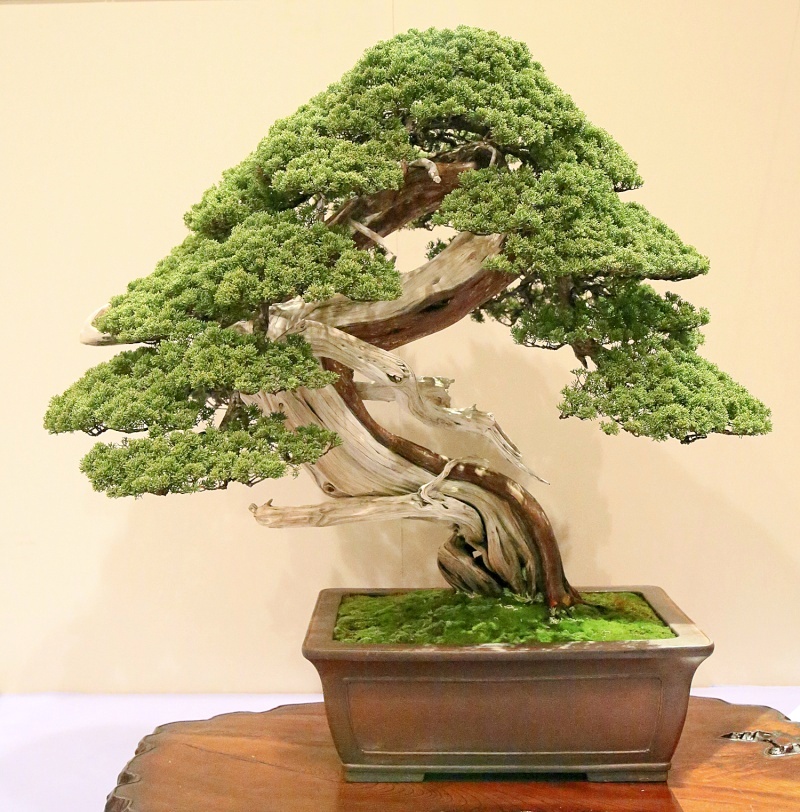
|
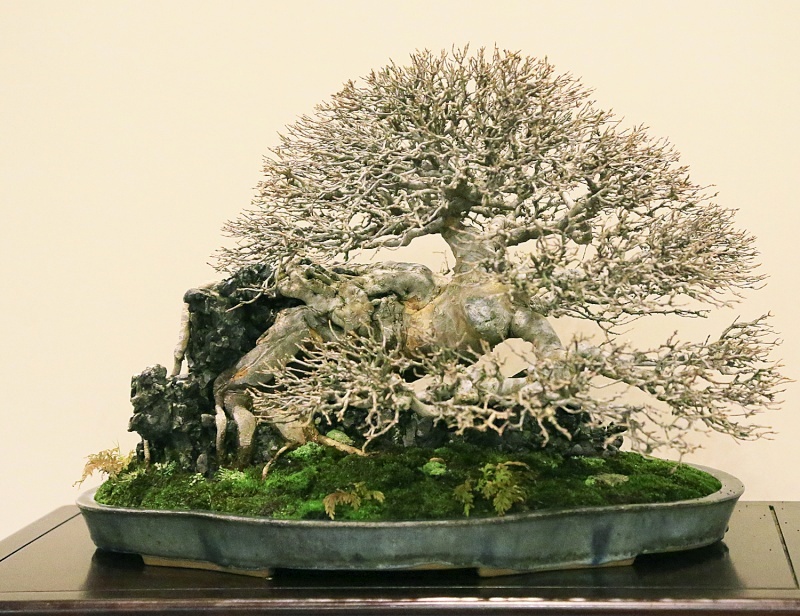
|
|
Sinuous trunk style Sargent juniper (Juniperus chinensis 'Sargentii')
displayed by Doug Paul,
Pennsylvania, USA at 2013 Kokufu Ten |
Root-over-rock style Trident maple
displayed by Matt Ouwinga, Chicago, IL, USA at 2013 Kokufu
Ten
|
The first American to ever have an entry selected for inclusion in the
show was Doug Paul from Kennett Square, PA. His Japanese hemlock (Tsuga diversifolia) was being
shown at the 2010 exhibition (see about a third of the way down and on the righthand side of the
photo page). Doug was on the
NBF
Board of Directors. (This hemlock bonsai was purchased by Doug in Japan from Isao Omachi and was
going through the lengthy two year post-entry quarantine period before it arrived to
The Kennett Collection. Doug's Juniper that was in
the Kokufu Ten in 2011 was lost
forever to the sea during the
Great Tsunami.
The good news is that the amazing Hemlock was safe in the USA during quarantine.)
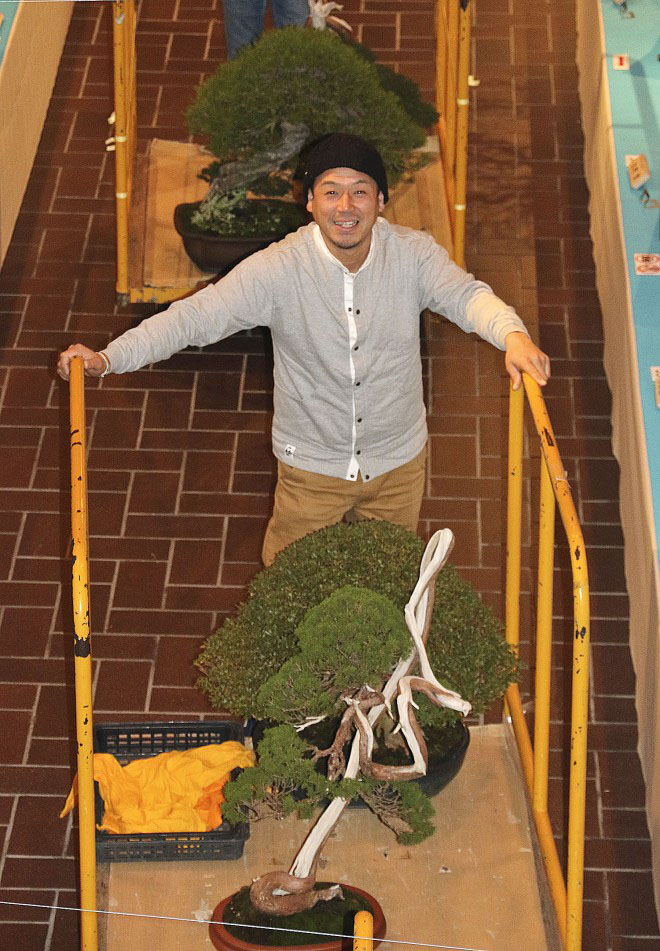
|
A happy Isao Omachi breaking down the display at the 2015 Kokufu exhibition.
Photo by Bill Valavanis.
|
"Isao Omachi's house and bonsai nursery were swept away in the [2011]
tsunami. That's the tough news. The good news is that hundreds, maybe thousands of people in our
international bonsai community donated to help Isao and his family get back on their feet. As a result
of this effort (and Isao's and his family's determination) Isao is back doing what he loves."
Constantino Franchi of Italy had a Ficus titled "Made
in Tuscany" in the 71st Kokufu Ten in 1997. That tree was subsequently adopted by Kunio Kobayashi for his
collection. A California juniper (Juniperus californica) designed by American Ernie Kuo was donated
to Prime Minister Obuchi and was displayed at the 74th Kokufu Ten in 2000. (This juniper had not faired
well in the Tokyo area and was said to be nearly dead in a large wooden box at the Kato garden.) Polish
artist Mario Komsta, an apprentice of teacher Nobuichi Urushibata
in Shizuoka for a few years, was a recent exhibitor. Mario had a Japanese red pine (Pinus
densiflora) selected for the 80th Kokufu Ten in 2006. (That tree was styled for himself not
for a customer [as was previously reported here]. As of September 2012, Mario still had this tree with
him in Spain, and the previous year it was at the Noelanders Trophy competition in Europe.) And a number
of other non-Japanese have assisted during their apprenticeships to Japanese bonsai masters in preparing trees
for other showings.
Many of the famous "Japanese" bonsai (Chinese quince, Korean Hornbeam, Pomegranate) often displayed in Kokufu
Ten were originally imported from Korea, China, Taiwan, etc., either as field-grown or, less commonly,
collected stock.
From 1914 through 1933, the All-Japan Bonsai Exhibition was held annually in
Hibiya Park in Tokyo. (Another
large annual show during this period was the Zen Nihon Bonsai Ten, also in Tokyo. These displays were
held from 1928 to at least 1931, and each was also commemorated with an illustrated show album of perhaps 80
pages in length.)
Beginning in 1934, the Kokufu Ten succeeded the Hibya Park exhibit and it
is now the oldest continuous -- except during World War II -- public exhibit in Japan. Author, editor
and publisher Norio (Toshio) Kobayashi (1889-1972, see Apr 1)
was the driving force behind the establishment of the Kokufu Bonsai Society and the Kokufu Ten exhibition.
He led the efforts at promoting the concept of exhibitions of bonsai at art museums, dubbed
"Bonsai Art Campaigning." The President of
the House of Peers and miniature bonsai enthusiast, Count Yorinaga (Raiju) Matsudaira
(1874-1944, see Sep 13), also helped organize
the Kokufu Ten and was the society's first president. Ninety-six trees were in that initial exhibition.
At the time museum officials did not originally want to display bonsai because they were "dirty" with soil and "smelly"
from organic fertilizers. That was the main reason soil needed to be 100% covered in green moss. The
original museum venue was a grand building with lots of front steps outdoors. There were then two curved
staircases leading down to the ground floor where all the bonsai were displayed in one huge open room with a
transparent roof which was great for allowing natural light which is desirable, for maintaining both evergreen and
deciduous trees indoors for about a week. Trees must be kept at appropriate temperatures and humidity levels
when displayed for health reasons. The event (before the Pacific War) was held twice in the spring and autumn,
based on the advice of sculptor Fumio Asakura, who said,
"Bonsai is a place to enjoy the seasons, and it is preferable to hold it in the spring and autumn."
Because of a rapid increase in the number of bonsai enthusiasts in
Japan in the early 1960s, the need to transform the private Kokufu Bonsai Society into a nationwide public
organization became obvious. In February 1965 the Kokufu Bonsai Society was dissolved and reorganized to
become the parent body of the Nippon Bonsai Association.
Shigeru Yoshida
(1878-1967), the former diplomat to London who had been the first prime minister in post-war Japan until 1954,
was its first president. The NBA assumed the role of organizer of the annual Kokufu Bonsai Exhibitions.
The association in the 1990s had more than 300 chapters nationwide with approximately 20,000 members and some 300
other members in 30 countries throughout the world. By the 2020s there were perhaps only some 5,000 members (per
Kimura-Kobayashi conversation, Part II, WABI Channel, 13:30 mark).
(Initial material from
"The
Best Bonsai and Suiseki Exhibits in Japan" by Thomas S. Elias, originally on pg. 12 (of pp. 10-14 article)
of the May/June 2002 issue of Bonsai Clubs International's Bonsai Magazine); with some additional material
from Morita, Kazuya and NBA Editorial Staff "Bonsai in Japan," in Tsukiyama, Ted T. (ed.)
Bonsai of the World, Book I (Japan: World Bonsai Friendship Federation, 1993), pp. 89-90; Kobayashi, Norio
Bonsai -- Miniature Potted Trees (Tokyo: Japan Travel Bureau, Inc.; 1951, 1962, 1966), pg. 167;
Bonsai Tonight's article "Green Club", and
"The
Kokufu Gamble" by Cheryl Manning, a revised and expanded version of an article that originally appeared in
Golden Statements magazine; plus substantial material from personal e-mails to RJB from William N.
Valavanis, especially while the latter was in Tokyo during the 2006 show. Exhibition re-location per
e-mail from WNV 7 Jan 2010, and Sakufu Ten move from January to December per WNV 30 Nov 2011. And
material from the discussion thread,
http://web.archive.org/web/20100212152743/http://ibonsaiclub.forumotion.com/announcements-f5/american-s-bonsai-display-at-kokufu-bonsai-ten-exhibition-t2266.htm.
Quote from 2011 from WNV posting to Internet Bonsai Forum, 15 Feb 2011,
http://ibonsaiclub.forumotion.com/t5641-2011-85th-kokufu-bonsai-exhibition.
E-mail communication between RJB and Mario Komsta on Facebook, Sept. 22-23, 2012. 2013 ticket from Facebook posting by Isao Omachi,
Japan, 27 Jan 2013. Info and photos for 2013 from 7 Feb
Internet Bonsai Club forum posting by WNV, with e-mails to RJB from WNV in response to several questions on 6 and 7 Feb 2013;
2014 photos and information per WNV's blog;
"Back
on His Feet -- Isao Omachi Four Years Later," Bonsaibark blog, 04/27/15;
Kokufu 90 Part I photos by Larry Ragle; 2018 photos and information per
WNV blog, Part 1a,
WNV blog, Part 1b,
WNV blog, Part 2a, and
WNV blog, 5th Suiseki.
2019 information per WNV
blog, Part 1a and WNV
blog Part 2a. 2020 information per
WNV blog, Part 1,
Part 3,
Part 4, and
WNV blog, 7th Suiseki.
WNV blog, Surprise Visit To
Omiya 2023,
2023 Part 1,
2023 Part 4, and
2023 10th Suiseki, and
2024 Part 1,
2024 Part 2,and
2024 61st Suiseki
Exhibition -- Part 1. Please do take a look at these blogs: there are many more photos of the other various
trees and viewing stones in them. VSANA News 2024, August 2023,
"The Future of the Meihin-ten." Imperial Household exhibits in 2020 and Mr. Suzuki per Makiko Koba's Facebook posts
of 02/11/20. 2018 ticket images from WNV to RJB via Facebook Messenger Feb 15, 2018. Fumio Asakura quote per
Google translation of http://bonsai-kyokai.or.jp/kokuhuten.htm accessed 08/30/20, from Makiki Koba's Facebook post the day
before. "Sales area of Kokufu Ten," (Feb.
4, 2013 and Feb. 4, 2016).
Excerpts from "We Be Green Clubbin"
by Aarin Packard, May 15, 2014, Capital Bonsai, which has many photos. Bjorn Bjorholm bio excerpt from
his website, http://www.bjorvalabonsaistudio.com/bjorn_bjorholm/,
and this BonsaiEmpire article with photos by Bjorn,
https://www.bonsaiempire.com/blog/kokufu-ten.)
|

